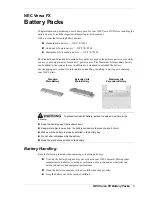
Recovering deeply discharged lithium batteries
The charger detects cell voltages in order to start the charging process if the voltages are too
low. It starts recovery of the battery pack by charging with a very low charging current of 0.5 A.
As soon as a voltage is reached that allows rapid charging, charging is continued with a higher
charging current.
g) Inductive charging (wireless)
Lay your mobile device on the charging pad
(7)
with its rear side facing down. Position it on
the centre of the anti-slip strip
(4)
to charge it. Charging starts when the charger is connected
to the power supply.
You can charge smartphones such as the iPhone X, iPhone XS, iPhone 11, iPhone 11 Pro,
Samsung Galaxy S10, Galaxy , Huawei Mate 30, Huawei Mate 30 Pro, Xiaomi 9,
Xiaomi 9 Pro and other devices that support induction charging.
You can use this charging function while using another charger function.
Errors and error messages
Error message
Possible cause
Recommended solution
CONNECTION BREAK
Battery and charger are dis-
connected.
Ensure that the contacts are
free of dirt and grease and not
oxidised. Connect the batteries
correctly.
Check the connections.
BALANCE CONNEC-
TION ERROR
Balancer cables are not con-
nected correctly.
Check the balancer connec-
tions.
Insert the balancer cables so
that they are aligned to the right.
CONNECTION ERROR
- CHECK MAIN PORT
The battery voltage is higher
than the standard battery
voltage.
Disconnect the battery from the
charger.
CELL VOLTAGE HIGH
The battery cell voltage is
higher than the normal ma-
ximum voltage.
Disconnect the battery from the
charger.
REVERSE POLARITY
A battery was connected
with the reverse polarity.
Connect the battery with the cor-
rect polarity.
OVER CHARGE CAPA-
CITY LIMIT
The maximum charging
capacity was exceeded (0 -
50000 mAh).
Disconnect the battery from the
charger.
DC IN TOO LOW
The DC input voltage is lo-
wer than 9.0 V or lower than
the set voltage.
Connect a suitable DC voltage.
DC IN TOO HIGH
The DC input voltage is gre-
ater than 32.0 V.
Connect a suitable DC voltage.
OVER TIME LIMIT
The set charging time was
exceeded.
Select a charging time between
0 and 720 minutes.
(Factory setting: 180 minutes)
INT.TEMP TOO HIGH
The charger temperature is
higher than 95 ºC.
Disconnect the charger from
the power supply and let it cool
down.
EXT.TEMP TOO HIGH
The battery temperature is
higher than the set tempe-
rature (20 to 80 ºC, default
setting = 50 ºC).
Disconnect the charger from the
power supply and let the char-
ged batteries cool down.
BATTERY WAS FULL
A fully charged battery was
connected.
Remove the battery from the
charger.
NO NEED TO CHARGE A rechargeable battery was
connected for the storage
setting, but already has the
correct storage voltage, e.g.
a LiPo battery with a voltage
of 3.8 V.
Remove the battery from the
charger.
POWER DISTRIBUTI-
ON NEEDS TO BE AD-
JUSTED
The set power distribution
between the charging chan-
nels is incorrect. 100% of
the power is set to channel
1, but a battery is connected
to channel 2 for charging.
Remove the battery from chan-
nel 2 and connect it to channel
1, or adjust the power distribu-
tion.
Care and cleaning
Never use aggressive detergents, rubbing alcohol or other chemical solutions, as
these may damage the housing or stop the product from functioning properly.
• Disconnect the product from the power supply before cleaning. Pull the mains plug from the
mains socket or disconnect the DC power supply.
• Use a dry, lint-free cloth to clean the product.
• To prevent scratch marks, do not press too hard on the surface of the enclosure or LCD
display when cleaning.
Disposal
Electronic devices are recyclable waste and must not be placed in household waste.
At the end of its service life, dispose of the product in accordance with the applicable
regulatory guidelines.
You thus fulfil your statutory obligations and contribute to environmental protection.
Technical data
Input voltage/current ..................... 100 - 240 V/AC, 50/60Hz, 3.5 A or 9 - 32 V/DC
Output voltage .............................. 0.1 - 30 V
Charging power ............................ 160 W/AC (channel 1 + channel 2,
supports power distribution) or 2 x 200 W/DC
Charging current ........................... 2 x 0.1 - 10 A
Balancer current ........................... max. 1000 mA/cell
Capacity limit ................................ 100 - 50000 mAh, cut-off
Charging cut-off ............................ 1 to 720 minutes
Temperature cut-off ...................... 20 -80 ºC
Charging power ............................ Max. 10 W (inductive)
DC power supply .......................... 20 V/DC, 25 A, 500 W or higher (not included)
Discharging power ........................ 6 W, (200 W with external discharge device)
Suitable for ................................... 1-6S LiPo/LiHV/LiIon/LiFe rechargeable battery
1-16S NiCd/NiMH rechargeable battery
1-12S Lead rechargeable battery
Temperature sensor cable ............ Not included,
can be ordered with Conrad item no. 2258298
Operating conditions ..................... 0 to +40 °C, 0–90 % relative humidity (non-condensing)
Storage conditions ........................ -20 to +60 °C, 0–90 % relative humidity (non-condensing)
Dimensions (L x W x H) ................ 100 x 99 x 64 mm
Weight .......................................... 448 g
This is a publication by Conrad Electronic SE, Klaus-Conrad-Str. 1, D-92240 Hirschau (www.conrad.com).
All rights including translation reserved. Reproduction by any method, e.g. photocopy, microfilming or capture in electronic
data processing systems, requires the prior written approval of the publisher. Reprinting, also in part, is prohibited. This
publication reflects the technical status at the time of printing.
Copyright 2020 by Conrad Electronic SE.
*2267182_v2_1120_02_DS_m_2L_1




























